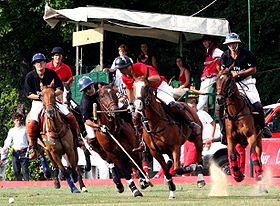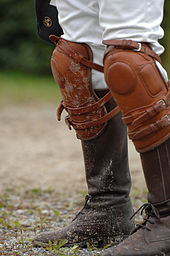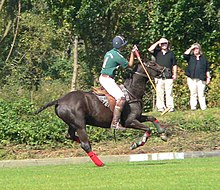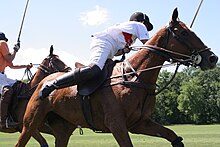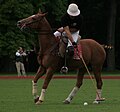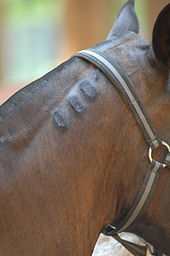Polo (sport)
Polo is a team sport in which the four horse- riding players per team hit a ball with a long wooden stick into the opponent's goal . The players wear helmets and change horses several times during the game.
term
The Anglo-Indian term polo has been used since the second half of the 19th century. It comes from the Balti language and means "ball" (see also Tibetan pulu for the same meaning ).
In the sport of polo on horseback, different variants are played, which differ from one another in terms of tactics and team composition : beach polo , arena polo and snow polo .
History of polo

The beginnings of the game of polo (Persian tschougān ) lie in Iran , Afghanistan, Kashmir and northern Pakistan (Persia) around 600 BC. The game became more and more popular over time and eventually became a national sport. In the 16th and 17th centuries, for example, the central square of the former Persian capital, Isfahan, regularly served as a playground. The Shah watched the game from the balcony of the Ali Qapu Palace. From earlier times it has been proven that the game enjoyed great popularity among both sexes and was also played together, so u. a. at the Sassanid court. Reports on this sport can already be found in scenes from Persian mythology , e.g. B. in the epic Shahnameh . In Afghanistan there is a sport distantly related to polo, buzkashi . In the course of the Islamic expansion , the game spread to Arabia and, under the Mughal emperors, to India .
The game of polo found its way into the Roman Empire as early as late antiquity . In addition to the imperial palace in Constantinople, there was a polo pitch, which is said to have been laid out by Emperor Theodosius II , to whom the game could have been taught by his Persian chamberlain Antiochus.
British cavalry officers from the Lancers ( Uhlans ) stationed in India brought Polo to Great Britain in the 19th century . The first British polo club was founded in 1859. Polo was an Olympic discipline in 1900 , 1908 , 1920 , 1924 and 1936 . The first three tournaments were won by a British team, the last two by an Argentine.
Ernst von Heintze-Weißenrode got to know polo as a German Legation Councilor in Buenos Aires and also introduced it in Germany. On January 3, 1898, he was one of the founders of the Hamburger Polo Club , the first polo club in Germany.
game
Playing field and polo staff
The size of a normal playing field is 300 yards (approx. 274 meters) by 200 yards (approx. 183 m). Arena Polo fields , which include Beach Polo , have different sizes.
The boundary of a normal playing field consists of 30 cm high, mostly wooden, boards on the long sides and lines marked in the grass on the short sides, the goal sides. Arena Polo limits are different, with promotional "boards" often used. The playing field boundaries may also be generously crossed by the horses.
To mark the game, the field is divided with a total of seven mental lines, the start and end points of which are marked on the boards opposite. There is a center line and a 60-yard, 40-yard, and 30-yard line in each half of the field.
Each goal consists of two approx. 3 m high, conical, mostly braided goal posts (pylons) and is 8 yd (approx. 7.20 m) wide. The posts are not firmly anchored in the ground, but rather give way if a rider and his horse bump into them in the heat of battle, and they can even fall over completely. Two goal judges, each placed in the middle behind the goals, indicate with a waved flag whether the ball has gone into the goal or not. Flag waved up means “goal”, flag waved down means “outside the goal and playing field”.
Other helpful polo staff at tournaments, among other things, take the time and ring the bell, take minutes, operate the score board and put the boards back up.
The horses are looked after by the grooms of the horse owners and polo players. You are responsible for quickly changing horses during the game or during breaks, as well as for preparing the horses, looking after them (on the so-called “pony line”) and after-game care.
Course of the game
The game is played with two teams of usually four players each, with snow and arena polo often two or three players each and with beach polo usually two players. In addition, two mounted referees ride along, and a head referee stands in the middle of the field on the edge of the field to make a final decision in the event of disputed judges' decisions. The game is in slow sections (so-called. Chucka divided, or "chukka", "Chukka"). Each time period lasts seven minutes, but can be extended by 30 seconds after the bell has sounded, provided the ball is in play, the ball does not touch the boards or goes out of bounds and no foul is committed. A game can be anywhere from four to eight periods of time. After every goal scored, all players line up in the middle of the field to “line up” and then “throw in”. The direction of play changes after each goal in order to compensate for one-sided advantages - e.g. due to the position of the sun or a possible slope of the terrain. The line-up of the players is therefore such that they always face the goal to be played. A throw in of the ball takes place at the beginning of a time segment, where the previous time segment ended. If the ball goes out of bounds via boards, the throw in is carried out from this point. A social factor is entering the square together ("tread in"), which is operated in the longer break between the second and third time period. In addition to the field attendants who are already in charge of the field, tournaments also ask the audience to plug the holes made in the field by the horses' hooves with the associated lumps of earth and tufts of grass.
regulate
The protection of horses is the top priority of the regulations. For example, a horse may not be used in two consecutive chuckas, and any possible danger to an animal leads to the immediate interruption of the game (on the other hand, if a player falls, and if the referee does not consider it to be a serious fall, the game continues). This rule enforces that a player must travel with at least two horses per tournament.
Allowed Actions
- Hook: A player may hook an opponent's stick with his own to prevent him from hitting the ball.
- Push: A player may be pushed off the line by means of his own body or that of the horse (so-called "ride off").
Actions not allowed
- Hook / Stick: The polo stick ("stick") may only be hooked shortly before the hit, not in a vertical position.
- Push: Under no circumstances should you use the elbow technique.
- Sandwich: Two players on the same team are not allowed to pinch a player from the opposing team.
- Crossing the line of the ball: Probably the most common foul in polo is violating the right of way. If the ball is in motion after a long stroke and several players are chasing after it, the player who is closest to the line of the ball has the right of way . If another player crosses the imaginary line between the ball and the player with right of way, he commits a foul.
- Appealing: Using the polo stick to indicate a foul
- Helicoptering: circling the polo bat over the head, e.g. B. in the case of a goal or to indicate a foul
Game tactics
Each of the four players on a team has a clearly defined tactical task:
Number 1 is the team's direct connection to the opposing goal. He determines the pace and speed of his team. He keeps the ball in play and tries to play it from the outside lines in front of the goal or at least in the middle of the playing field. He covers the opponent's No. 4.
Number 2 is the connection between player number 1 and player number 3. It covers opposing number 3, who is usually the strongest player on the opposing team. He gives his No. 1 the appropriate templates. Depending on the course of the game, he occasionally takes over the position of No. 1.
Number 3 is the pivot of the team. He shapes the game through the strategic use of his teammates. He organizes the defense and attack behind an invisible line, behind which he and his No. 4 operate. He covers No. 2 of the opposing team.
Number 4 covers opponent's number 1. He only hits the ball when he is absolutely sure that he will hit it. Otherwise he immediately turns and tries to ride his opponent down.
Like the links in a chain, each player position builds on the other. The main characteristics that determine the qualities of a polo player are therefore physical fitness, the ability to anticipate and react, dexterity in mastering the horse and, above all, team spirit. An optimal team performance results from the good interaction of the performance of all four members.
Handicap
Every polo player has a personal handicap , depending on their level of performance , which starts at −2 and can go up to +10. The best polo players in the world with a handicap of +10 are currently almost all from Argentina . The sum of the four individual handicaps form the total handicap of a team. If teams with different handicaps compete, the team with the lower handicap receives a goal lead. High Goal Polo is the top division; here the team handicap starts at +8. In every tournament that is played according to DPV rules, the number of permitted players from abroad, who are usually employed as professionals from Argentina, is also regulated. When playing in a limited arena, the handicap is one level higher (+1) than when playing polo on the open field.
| Division | Team handicap limits | individual limit | Restrictions |
|---|---|---|---|
| Low Goal DM (German Championship) - DM Amateur | from −2 to +2 | from −2 to +2 | not a foreigner |
| Low Goal - Amateur Polo | from −2 to +2 | from −2 to +2 | Foreigners, min. +3 |
| Low Goal - Amateur Polo | from 0 to +4 | from −2 to +2 | only one +4 player
1 foreigner, at least +3 |
| Medium Goal DM | from +2 to +6 | from −2 to +5 | only one +5 player
1 foreigner, at least +3 |
| Medium goal | from +4 to +8 | from −2 to +5 | only one +6 player
1 foreigner, at least +3 |
| High Goal DM | from +8 to +12 | from 0 to +10 | Max. 2 foreigners, at least +3 |
| High goal | from +10 to +12 | from 0 to +10 | Foreigners, at least +3 |
Equipment and presentation
equestrian
The player must wear a helmet. Polo helmets are wider than classic riding helmets, but this has purely aesthetic reasons, because the polo helmet has its roots in the tropical helmets of the colonial era.
Contrary to legend, the short-sleeved polo shirt - an invention of the French tennis legend René Lacoste - does not come from polo, but from tennis and was only gradually adopted by other sports such as polo after 1933.
Until the second half of the 20th century, classic white breeches (often in their flared form, breeches ) were worn, nowadays you see almost exclusively white jeans, either normal leisure models or special versions without an inner seam.
Like to be Gaucho Belts , belt with traditional Argentine weave patterns worn.
Thickly padded leather knee pads are used against knee blows.
The typically brown and zippered polo boots are often provided with spurs.
Often the players wear special gloves with a reinforced back as protection against blows.
The watch model Reverso from the Swiss manufacturer Jaeger-LeCoultre was originally designed for the polo player . The actual watch can be turned around in a guide so that the - earlier fragile - watch glass points inwards towards the wrist of the wearer and is thus protected against damage during sporting use.
The undisputed market leader for competition outerwear in Germany is the Argentinian manufacturer La Martina . Clubs and boots often come from medium-sized artisan workshops in Argentina.
When the players use a riding crop , hold it in their left hand. Mostly extra-long (up to 1.2 m) models are used.
horse
- Polo saddle
The seat of a polo saddle is often made of suede. Instead of the saddle belt buckles, traditional saddles have a long leather strap that is often wrapped in a large ring and thus tightens the waist belt. In addition, saddles in polo have their own safety belt for double protection, which runs over the saddle in case the saddle loosens or even comes off during the game. There are no knee rolls on the saddle flaps like on European saddles.
- Bridle and harness
In principle, any traditionally used bridle can be used. The bit of the bridle is usually sharp in order to maintain control at higher speeds. It is ridden with double reins throughout . Draw reins are often used. Auxiliary reins are often used in polo to prevent the horse from jerking its head up and thereby keeping it more under control.
- Leg protection
As with other equestrian sports, bandages, gaiters, jumping bells and other aids are used to protect the horse's legs. In contrast to other equestrian sports, however, the horse's legs are often bandaged and tendon guards or gaiters are put on over them.
- Long and short hair
Since the polo stick would get caught in the horse's tail when it swung back a long way ("full swing"), the tail is now bandaged ("taped"), in the past it was even completely docked . The manes are shorn for a similar reason so that the long hair does not interfere with the reins and the view of the ball.
game
- bat
The polo stick ( mallet , stick ) is always held on the right (also by left-handers). It consists of a wooden, cylindrical face which is bevelled on the side facing the horse and which is also called a "cigar" because of its shape. The handle extension is made of bamboo or fiber composite material, the handle is shaped similarly to a sports saber . A loop that is put around the thumb and then passed over the back of the hand prevents the player from losing his stick when he lets go of it. The type of winding also ensures that the player can drop the club immediately if it should get caught anywhere. The length of the clubs varies depending on the size of the player and his horse and is measured in inches . Common polo clubs range from 48 to 53 inches. It is noteworthy that, unlike in many other sports, technical advancements are hardly accepted, but the sports equipment in principle persists in its original form.
- Balls
The polo balls for normal grass polo are seven to eight centimeters tall, weigh about 130 grams, are white and consist exclusively of hard plastic. Polo balls for snow or beach polo are about 20 centimeters tall and mostly red, consist of hard rubber filled with air and are therefore much lighter so that they do not sink into the sand or snow.
Riding style
The riding style is largely quite different from classic riding styles such as the traditional English or western riding style.
- Seat and posture
The stirrup leathers are strapped rather short. The player turns when he hits the ball, but does not stand in the classic stirrups, but turns in the saddle and leans on his tightly closed knees. He either hits the ball in the half-seat position or while sitting in the front part of the saddle. What is important is the turn to the ball, which you see in all top players.
Commands
- Break in and increase speed
The horse is driven with thighs, upper body and reins. To signal the horse to move forward, the lower legs are put back more or less, depending on the desired intensity, the upper body or the body's center of gravity is shifted forwards and the hand holding the rein along the mane crest is also moved more or less forward.
- Reduce speed
Depending on the desired intensity of braking or stopping, you shift your upper body backwards, sit firmly in the saddle and push your legs forward. The rein hand also automatically goes back slightly. The rein hand is only actively and vehemently used to brake when the vehicle is quickly “stopped”.
- Change of hands
To change hands of the horse at a gallop, first turn the upper body in the new direction, move the rein hand slightly upwards and shift the weight backwards so that the horse can relieve the front legs to change hands. In addition, a slight pressure on the outer leg supports changing hands.
Striking techniques
- Half swing: Half swing
- Full swing: full swing
- Offside: Hit on the racket carrying (right) side
- Nearside: Hit on the (left) side facing away from the club
- Forehand: Hit in the riding direction
- Backhand: Hit against the riding direction
- Under the neck: punch under the horse's neck
- Under the tail: punch behind the horse
- Back open
The stroke is performed backwards, with the ball more likely to be hit away from the horse.
- Back tail
The stroke is taken backwards with the ball passing behind the horse.
“Offside” sequence of movements In the preparation phase, the player rises from the saddle “out of the pony” and mainly leans on his clamped knees. As in tennis, the right arm is brought backwards close to the body. When swinging, the upper body is bent downwards and the legs act as springs to balance the horse's movement. The ball is hit at the level of the lower leg. After the ball is hit, the bat continues to follow the forward swing.
"Nearside" movement sequence The arms are crossed, whereby the rein guidance must still be present. Otherwise the shot is executed similarly to an "offside" shot, only that everything is coordinated with the left side.
“Under the neck” sequence of movements The ball is hit much earlier and further forward so that the bamboo stick of the racket can swing through under the neck.
Polo horses
Even if the rules allow polo to be played on any horse, specially bred polo ponies are mostly used, most of which come from Argentina ( Polo Argentino ). The height of the polo ponies is usually around 1.50 m. The AACCP, the Argentine association of breeders of polo horses, has defined the height of the "Polo Argentino" as 1.56 cm since 1984. For the most part, mares are used to play polo. Quite often, former racehorses are retrained into polo horses and used in games, or they are bred with them. The remarkable thing is that horses, which are naturally shy escape animals, have to develop a fighting and hunting spirit in polo and allow the bat to be handled around their head.
Polo in different countries
Polo is played today in many countries around the world.
Argentina
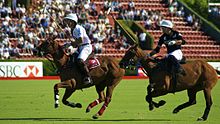
Polo is more widespread in Argentina than in Europe. Originally introduced there by the British, the sport quickly gained in popularity. On the one hand, this is probably due to the resemblance to Pato , on the other hand, the rural dwellers could ride well, and there were horses on every estancia. Today the best players in the world come from Argentina and whole families are involved in polo, such as: B. the Heguys or the Novillo Astradas .
United Kingdom
The UK is the country with the largest base of polo clubs in Europe. The HPA has around 50 UK clubs on its list, most of which are in the Greater London area. In Great Britain, polo is also played as a sporting activity at numerous universities (above all at elite universities such as University College London (UCL), the London School of Economics (LSE) and the University of Oxford , University of Cambridge ), so that it is constantly growing young player is secured. Great Britain’s strongest players at the moment include a. the brothers Mark and Luke Tomlinson , the latter with a handicap of eight in Argentina, and James Beim, Henry Brett and Tom Morley.
Germany
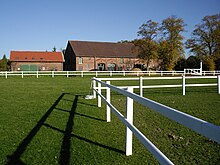
In Germany , the polo scene in 2012 with 258 active polo players is quite manageable compared to the Argentine polo scene. For historical reasons, Hamburg is likely to have the honor of being the unofficial center of polo; four polo clubs with around 60 members are based there, including the Hamburger Polo Club in Flottbek , which is considered the oldest polo club on the European mainland; also the seat of the office of the German Polo Association is there. The number of clubs in the Berlin - Brandenburg area is also very high, where the German high-goal polo championships have also been held since 2008. The championships in medium and low goal are awarded each year to an applicant member club of the DPV. There are also polo clubs in the vicinity of all other major German cities, particularly in Munich and Düsseldorf . The best German player with a handicap of +4 is Thomas Winter (Hamburg), followed by Christopher Kirsch ( Groß Offenseth-Aspern ), with an HDC of +4. The German polo scene is supported by foreign players ("playing pros") and grooms, who are an important pillar of sport in Germany in terms of sport as well as customs and traditions .
Austria
In addition to the polo club in Ebreichsdorf near Vienna, where the 2010 European polo championship was held, and the Dienst'l Gut in Launsdorf Hochosterwitz near Klagenfurt ( Carinthia ), the A Quechua polo school Graz / Kumberg has also been under the management since 2013 of the Polo Instructors and Players Association President Dr. Uwe Seebacher (HC 2). There are also other polo clubs near Wiener Neustadt and in Niederweiden in Lower Austria.
In addition to the polo schools and clubs, several polo events were also able to establish themselves in Austria. With the so-called "Polo event in Kitzbühel " on snow and some events (e.g. in Bad Gastein or Seefeld in Tyrol ) of the Polo Instructors and Players Association Snow and Beach Polo Tour, there are polo events in Austria almost all year round which is now even reported on Austrian radio or other national and international media.
In 2016 the world polo congress - the POLO SUMMIT - will be held in Vienna. As part of this event, international experts from the sport of polo will give presentations and exchange ideas on topics such as development, safety, sponsoring, event management and many more.
Furthermore, the headquarters of the Polo Instructors and Players Association , or PIPA for short, is now also in Vienna , which of course promotes polo in Austria.
Switzerland

In addition to polo clubs in Ascona , Geneva , Bern and Zurich , the St. Moritz Polo Club was founded in 1959 , presided over by Dr. PR Berry, founded. The St. Moritz Polo Club has been the organizer of numerous summer and winter polo tournaments since 1960. The world's most prestigious and top-class winter polo tournament has been held in St. Moritz since 1985. The St. Moritz Polo World Cup on Snow is held on the frozen Lake St. Moritz and takes place at the end of January. Four high-goal teams with handicaps between 20 and 22 goals compete for the coveted " Cartier Trophy". On the four days of the tournament, two top-class games will take place every day, including the grand finale on Sunday. The world's best polo players from Argentina, Chile, Great Britain, Australia and other countries play. The special conditions on snow and the unusual location 1,800 meters above sea level demand something extraordinary from animals and people. In addition, the Polo Club Ascona , chaired by Uwe Zimmermann, was founded in 2009 , which is held every summer in Ascona at the old airport. The Silver Cup also takes place every year in Gstaad . Although night games with electric floodlights were already being held in England in the 19th century, “Night Polo on Snow” had its world premiere in 2005 in Klosters .
Liechtenstein
Polo has also been played in Vaduz in the Principality of Liechtenstein since April 2014 . In August 2014, the Liechtenstein national polo team with Gerardo Cosentino from Liechtenstein won the Beach Polo European Championship in Lignano, ahead of Slovakia and Italy. The Princely Polo Cup takes place every year. Princely Polo Cup is a registered trademark. Gerardo Cosentino has presided over the Princely Polo Cup, which is organized by the Princely Polo Club, since 2016. This now international tournament is held in Vaduz / Liechtenstein every summer.
United States
Every year from January to April, the International Polo Club (IPC) in Wellington , Florida hosts numerous high-level tournaments, in which many Argentinian professionals with high handicaps of +9 and +10 and polo players from all over the world take part. These include the US Open and the Gold Cup of the Americas.
Arena polo is played at the Tryon International Equestrian Center in North Carolina.
Tournaments
Triple Corona
The Argentine Copa Triple Corona tournaments are the most important polo tournaments in the world. The triple corona tournaments are in calendar order:
- Tortugas Open in late September / early October
- Hurlingham Open in November
- Argentine Open in December
All three tournaments are "open" championships. This means that differences in the handicaps of the participating teams are not compensated for by points ahead. The "Triple Corona" has only been won by a few teams in the history of Argentine polo:
- Coronel Suárez : 4 (1972, 1974, 1975 y 1977)
- La Dolfina : 3 (2013, 2014 and 2015)
- Ellerstina : 2 (1994 and 2010)
- Santa Ana: 1 (1973)
- La Aguada: 1 (2003)
European Championship
The European championship in polo has been taking place since 1993. In 2010 the EM took place in Ebreichsdorf, Austria. At the 2016 European Championships in Berlin, Ireland won ahead of France and Germany. The German women's national polo team won the gold medal in Italy in 2018.
World Championship
The polo world championship was held for the first time in 1987. It currently takes place every three years. The team handicap is limited to 14 in order to be able to find enough participating countries and to give all participants a fair chance to win. The most successful nations so far have been Brazil and Argentina with six medals each, Germany has not yet won a medal.
Olympic games
→ Main articles: Olympic Summer Games 1900 / Polo , Olympic Summer Games 1908 / Polo , Olympic Summer Games 1920 / Polo , Olympic Summer Games 1924 / Polo , Olympic Summer Games 1936 / Polo
Polo has been a discipline at the Olympic Games five times : 1900 in Paris, 1908 in London, 1920 in Antwerp, 1924 in Paris and 1936 in Berlin. Great Britain was the most successful nation here with a total of three gold, two silver and two bronze medals.
In addition to the tournaments mentioned, there are also numerous tournaments in grass and arena polo organized by individual polo clubs. The world's largest series in snow polo is the PIPA Snow Polo World Cup Tour . There are other notable tournaments in St. Moritz, Kitzbühel, Aspen and beach polo in Miami , Dubai or Germany (Sylt, Timmendorf, Rügen, Warnemünde) and the PIPA Beach Polo World Series .
Organizations
The Federation of International Polo (FIP) acts as the international umbrella organization of the national polo associations. There is also the Polo Instructors and Players Association , or PIPA for short, the world association of all polo players and coaches. There are also numerous national organizations, e.g. B. the German Polo Association , the Hurlingham Polo Association (HPA) in Great Britain or the Asociación Argentina de Polo in Argentina. Her tasks include a. the definition of the player handicaps, which can differ in the individual countries.
Prominent polo players
- past
In the 1930s polo became the sport of Hollywood's high society. B. the Warner Bros. Studios has its own polo team. Hollywood polo players included Jack Warner, producer Hal B. Wallis (" Casablanca "), and director Michael Curtiz , who owned 12 polo horses.
- present
Polo is very popular in the British royal family: Prince Charles was an avid polo player with a handicap of +2 at his best. He came to polo through his uncle, Louis Mountbatten, 1st Earl Mountbatten of Burma (formerly Prince of Battenberg ). He also wrote a book on the subject of polo under the pseudonym "Marco", which was long considered a standard work. Prince William (handicap +1) and Prince Harry are also active. Charles' father, Philip Mountbatten, Duke of Edinburgh , also played polo and is Honorary President of the Guards Polo Club in Berkshire .
Guitarist Mike Rutherford ( Genesis , Mike & the Mechanics ) plays polo at tournament level, as does model Jodie Kidd and American film actor Tommy Lee Jones (" No Country for Old Men "). Stefanie Powers (TV series: Hart but cordially (1979 to 1984)) has been playing polo since she was 18, today at high goal level.
Germany's best-known and oldest polo player (as of 2008), who has also made an organizational contribution to better acceptance of German polo in the international polo scene by bringing the FIP (Federation of International Polo) Ambassadors Cup to Germany for the very first time, is Hans Albrecht Baron von Maltzahn . The Hamburg businessman Albert Darboven , who played a key role in promoting and popularizing sport in Germany, is certainly well known beyond the region . The German cinema and television star Heino Ferch (handicap 0) and his wife, the former eventing rider in the German national team Marie-Jeanette Ferch (handicap 0) are active for the polo club in Landsberg- Ammersee. The European Championship participant Eva Brühl is considered the best German polo player (as of 2009).
Typical injuries in polo
Falls from the horse and / or rider are more common than in other equestrian sports. This is due, among other things, to the fact that motion sequences are neither uniform nor predictable. The use of a racket in the game and the fact that the players do not act separately from one another, for example in tennis, result in corresponding impact injuries. Mostly the horse's legs are hit, but the heads of horses and riders are also endangered.
variants
Variants of polo that are not played on horses are often played for relaxation or as a tourist attraction. These include: elephant polo , camel polo , bicycle polo , canoe polo and Segway Polo . Hobby horse polo is a children's game in the classic polo regions and is also played as a team sport with some humorous aspects, for example in Mannheim and Düsseldorf.
literature
- Carl Diem : Asian Equestrian Games. A contribution to the cultural history of the peoples. German Archive Publishing House, Berlin 1941
- Heinrich Hasperg: POLO . Grethlein & Co., Leipzig 1907. New edition Chevalier Verlag 2010, ISBN 978-3-941551-02-2
- Carl von Skal: Education and training of polo ponies . Verlag für Polosport, Vienna 1930. New edition Chevalier Verlag 2011, ISBN 978-3-941551-05-3
- Santiago Novillo-Astrada, Raphael De Oliveira and Uwe Seebacher: Simply Polo . BookRix, Munich, 2009
Web links
- Homepage of the German Polo Association (DPV)
- Hurlingham Polo Association (HPA)
- Federation of international Polo (FIP)
- Polo Instructors and Players Association (PIPA)
- Polo Players Handicap (FIP) - List of countries
- Homepage of the German-language polo magazine Polo + 10 Magazin
Individual evidence
- ^ Entry "Polo", Online Etymology Dictionary
- ↑ Uta von Witzleben : Firdausi: Stories from the Schahnameh. Eugen Diederichs Verlag, Düsseldorf and Cologne 1960, pp. 196–199 ( How Siawosch shows his skills in front of Afrasiab ) and 215-217 ( How Siawosch defeated the Turks in the game )
- ^ Britannica.com
- ^ Pegasus Event Marketing: History of Polo
- ↑ Alexander Demandt : The private life of the Roman emperors. 2nd edition, CH Beck, Munich 1997, ISBN 3-406-42510-0 , p. 162.
- ^ Heinrich Hasperg: Polo. 1907, reprint BoD 2010, ISBN 978-3-941551-02-2 , p. 11
- ↑ [1] Handicap distribution in Germany.
- ↑ Summer 2015. In: www.hurlinghampolo.com. Retrieved December 28, 2015 .
- ↑ Naanii Global Polo & Quality Lifestyle -Magazin 'en Vogue'-: 09. 2018, Polo - II. FIP Ladies European Polo Championship, 2018, Italy Villa a Sesta Polo Club: Congratulations to the German SIEGER Team - Congratulations Germany Gold medall and Italy Silver medal! , [www.naaniiglobal.com]
- ↑ Harmetz, Aljean: Arrest the usual suspects. Berlin Verlag, Berlin, 1992/2001, p. 80
- ↑ Title: "Stefanie Powers at Polo Tournament 2005" - Interview
- ^ Albrecht von Maltzahn Polo Personality of the Year 2005
- ^ Hugh van Skyhawk: Burushaski texts from Hispar: Materials for understanding an archaic mountain culture in northern Pakistan . In: Contributions to Indology . No. 38 . Otto Harrassowitz , Wiesbaden 2003, ISBN 978-3-447-04645-9 , pp. 196 .
- ↑ Colia Schliewa: Your hobby horse is polo. In: Express . June 23, 2013, accessed October 15, 2014 .
- ↑ The sport interview: What is the attraction of hobby-horse polo? In: The Rhine Palatinate . July 25, 2008, accessed October 15, 2014 .
- ↑ Trend sport hobby horse polo: I think my horse is cutting. In: Spiegel Online . September 2014, accessed October 15, 2014 .
